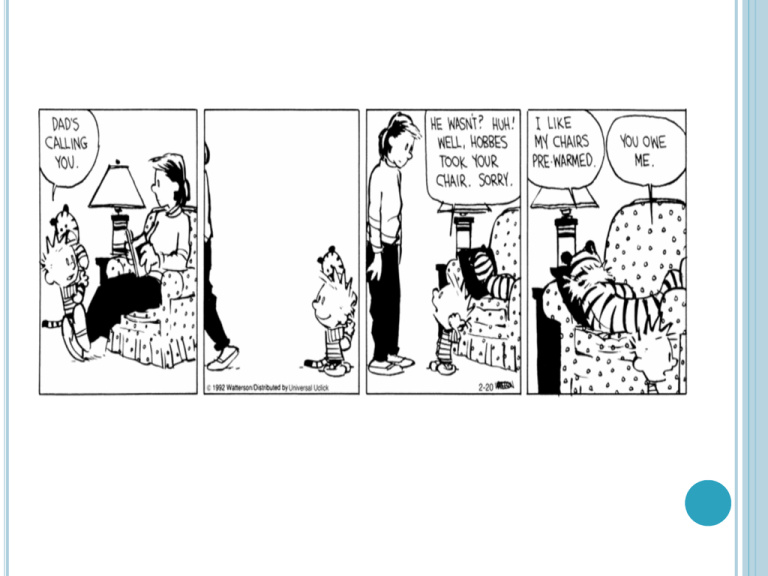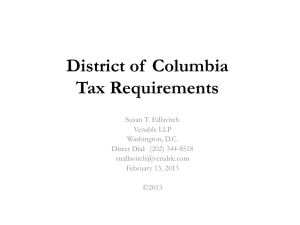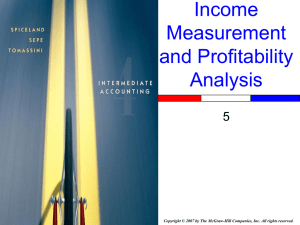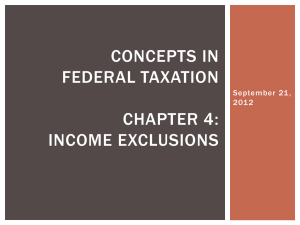Chapter 2: Earning an Income
advertisement

CHAPTER 2: EARNING AN INCOME Math 10-3 INTRODUCTION, VOCABULARY, WAGES AND SALARIES Who has had a job before? How did you get paid? Did you get paid overtime? How did they determine how many hours they worked? Did they have any deductions? Etc. IN ALBERTA, THE CURRENT MINIMUM WAGE IS $9.40 PER HOUR. Minimum wage is the minimum amount a worker MUST be paid an hour, as set out by the Provincial Government. The minimum wage in BC is $8.75/hour. The minimum wage in Sask. is $9.50. The min. wage in Ontario is $10.25/hour. why there might be differences in minimum wage across Canada? WHAT IS THE DIFFERENCE BETWEEN A SALARY AND A WAGE? Salary – paid a fixed amount every pay period. This amount is determined usually in a contract which is signed before employment starts. Advantages – paid the same amount every pay period, regardless of hours worked/holidays etc. Disadvantage – not paid for any extra work you might do. Wage – paid a fixed amount PER HOUR worked during a certain pay period. Advantages – paid for any extra hours you might work. Usually paid more per hour during certain times (for example, working on holidays, Sundays, evenings etc.) Disadvantages – if you don’t work, you don’t get paid (for example, if you miss a day of work, or you work fewer hours in a week than normal). Gross Pay – the total amount of money earned in a pay period. AKA gross earnings. This is the amount you make BEFORE deductions. A PAY STATEMENT IS A FORM AN EMPLOYER WILL GIVE YOU THAT SHOWS EARNINGS FOR A DEFINED PAY PERIOD. A pay period could be weekly, bi-weekly, monthly, etc. *weekly – once a week (paid 52 times per year) *bi-weekly – every two weeks (paid 26 times/year) *monthly – once a month (paid 12 times/year) *semi-monthly – twice a month (paid 24 times/year) *annually – one year (paid once a year) *HOW DO WE DETERMINE THE MONTHLY, SEMIMONTHLY, BI-WEEKLY AND WEEKLY PAY FOR A SALARY?* Ex. Brendan works at the Edmonton Journal. His annual salary is $35 650. Determine the following scenarios: If Brendan is paid monthly, how much will he make gross monthly? 12 pay periods per year: $35 650 / 12 = $2 970.83 / month Paid Semi-Monthly? 24 pay periods per year : $35 650 / 24 = $1 485.42 twice a month Paid Bi-Weekly? 26 pay periods per year: $35 650/26 = $1 371.15 every two weeks Paid Weekly? 52 pay period per year: $35 650/52 = $685.58 WHAT ARE THE ADVANTAGES AND DISADVANTAGES OF EACH PAY PERIOD? *HOW DO WE DETERMINE THE GROSS PAY FOR WAGES? EX: Morgan makes minimum wage. He works 35 hours one week. How much will his gross pay be for that week? *Multiply the number of hours worked by the wage to get gross pay!* 35 hours x $9.40/hour = $329.00 *Always round MONEY to two decimal places!!!* Employee Name: Christine Thomas Company: McDonalds Pay Period Begin: 09/18/2010 Pay Period End: 09/24/2010 GENERAL Employee ID: 555777 Job Title: Cashier Address: 2020 Kingfisher Blvd Pay Rate: 9.25/h HOURS AND EARNINGS Descri ption Rate Regular 9.25/h Hours Gross Earnin gs 25 $231.25 How often does Christine get paid? Weekly (24-18 = 6 days = 1 week) If Christine gets paid the same amount every week, how much will she make gross in a month? $231.25 x 4 weeks/month = $925.00 How much will she make in a year? $925.00 x 12 months/year = $11 100 Employee Name: Robert Cooper Employer: ATCO Gas PP Begin: 09/4/2010 PP End: 09/17/2010 Employee ID: 1234 Job Description: Technician Pay Rate: 15.45/h *determine using gross earnings and hours worked Descri ption Rate Hours Gross Earnin gs Regular 15.45/h 32 540.75 Sunday (rate + 1.00) 8 131.60 Total Gross Earnings 672.05 16.45/h How often does Rob get paid? Bi-Weekly (17 -4 = 13 days = 2 weeks) If Rob gets paid the same amount every pay period, how much will he make in a month? 2 x 672.05 = $1 344.10 If Rob gets paid the same amount every month, how much will he make gross per year? 12 x 1 344.10 = $16 129.20 ASSIGNMENT: SALARIES AND WAGES.DOC DAY 2: HOURS WORKED – COMPLETING TIME CARDS HANDOUT: ALBERTA.EMPLOYMENT.STANDARDS FULL TIME VS PART TIME Full Time – usually considered to be between 35- 44 hours per week. Typically, full time results in 8 hour shifts per day, 5 days a week. Part Time - usually considered to be less than 35 hours a week. Typically, part time results in shifts less than 8 hours OR fewer days are worked per week. Shift – the amount of time you work. GETTING PAID WITH A WAGE – HOW ARE THE HOURS YOU WORK TRACKED? Punch cards – at the start and end of every shift, you insert a card into a machine that will record the date and time. This card is then later used to calculate the number of hours worked during a pay period. Time Card (Personal) - you may have to manually record the time you start and end each shift. Sometimes this is called “logged hours”. Time Card (Pay Roll) – you may work for a company where a person logs your hours for you. It will be your responsibility to inform them of any extra hours you work, or any shifts you miss. 24 HOUR TIME – MOST JOBS WILL USE 24 HOUR (INSTEAD OF 12 HOUR) TIME. TO DETERMINE THE TIME, SUBTRACT 12. Remember, in 12 hour time, the morning is am, and the afternoon/evening is pm Ex. What time is 13:05? 13-12 = 1:05 pm What time is 22:45? 22-12 = 10:45 pm What time is 02:50? = 2:50 am HOW DO WE DETERMINE THE NUMBER OF HOURS WORKED? For example, you work from 9:30 – 14:50. How many hours have you worked? 1st add minutes to the start time to match the minutes of the end time 9:30 + 20 minutes = 9:50 2nd subtract the hours: 14 – 9 = 5 hours 3rd combine hours and minutes = 5 hours + 20 minutes. Employers don’t usually pay for every minute of work. Typically you will get paid for every quarter hour you work. Round to the nearest quarter (0, 15, 30, 45) 20 minutes – closest to 15 minutes. What part of an hour is 15 minutes? x/1 = 15/60 = 0.25 4th Add hours and parts of an hour together: 5 + 0.25 = 5.25 hours. EX: COMPLETE THE FOLLOWING TIME CARD: TIME CARD – Telus Communications Employee Number: 5872 Approval: Employee Name: Bill Ngo For Week Ending: 19/11/10 Date Start (IN) End (OUT) Total Hours 15/11/10 09:03 12:05 3 hours, 2minutes = 3 hours 16/11/10 16:02 21:06 5hrs, 4 mins, = 5 hours 17/11/10 08:58 12:00 3 hrs, 2 mins = 3hours 18/11/10 16:30 22:01 5 hrs, 31 mins = 5 hours and 30 minutes = 5.5 hours 19/11/10 08:32 12:00 3 hours, 28 mins = 3 hrs 30 mins = 3.5 hours Total Hours Worked during P.P. 20 hours IF BILL MAKES $10.25 PER HOUR, HOW MUCH WILL HE MAKE GROSS FOR THIS PAY PERIOD? 20 x 10.25 = $205 DAY 3: OTHER WAYS TO EARN – PIECEWORK AND COMMISSION SALARY AND WAGE AREN’T THE ONLY WAYS TO EARN AN INCOME. OTHER WAYS INCLUDE: Self employment – a person who works for themselves rather than for an employer. Piecework – when someone is paid a set rate for an amount produced Commission – an amount (usually a percentage) paid to someone for a business transaction Contract – a legal agreement that outlines terms, conditions and payments for work to be done Brainstorm as a class examples of occupations for each vocabulary words above. Also, brainstorm advantages and disadvantages of being self employed. PIECEWORK Ex. Michelle is an Artisan – a craftsperson who specializes in decorative arts. She makes pottery bowls. She sells large bowls for $45.00 and medium bowls for $35.00. One weekend at a farmers market she sells 11 medium and 8 large bowls. How much does she make? *Multiply price by quantity, then add totals together* $45 x 8 = $360 $35 x 11 = $365 Total: $745 COMMISSION REVIEW: PERCENT MEANS OUT OF 100! TO FIND THE PERCENT OF NUMBERS, CHANGE THE PERCENT TO A DECIMAL, AND THEN MULTIPLY THIS DECIMAL BY THE NUMBER IN QUESTION. Ex. Lindsay works at a car dealership. She gets 3% commission on all sales. Last month she sold a total of $44 375. How much will her gross earnings be? 1st change % to a decimal 3% = 3/100 = 0.03 2nd multiply decimal by total sales 0.03 x 44 375 = $1 331.25 Ex. Dan works as a real estate agent. He gets 0.2 % commission on the sale price of any house he sells. Last month he sold 2 houses: $299 450, and $380 200. How much will his gross earnings be? 1st Add up his sales: 299 450 + 380 200 = $ 679 650 2nd change % to a decimal 0.2% = 0.2/100 = 0.002 3rd multiply decimal by his sales. 0.002 x 679 650 = $1 359.30 Ex. Carl works at The Keg restaurant. He makes $8.80/h plus he gets to keep 75% of his tips. If one week he works 36 hours and makes $155 in tips, what will his gross earnings be? 1st find out his hourly wage amount $8.80/h x 36 hours = $316.80 2nd change % to a decimal, and multiply by his tips 75% = 75/100 = 0.75 0.75 x 155 = $116.25 3rd add his wage and tips together to get total $316.80 + $116.25 = $433.05 EX. ANDREW STARTS A NEW JOB SELLING APPLE COMPUTERS. THE COMPANY OFFERS HIM THE FOLLOWING PAY OPTIONS: Base salary of $500 plus 2% of all sales Straight commission of 6% Determine Andrew’s gross earnings for both options based on the following sales: Amount Option 1 Option 2 Gross Earnings Gross Earnings $0 $500 $0 $5000 $600 $300 $10 000 $700 $600 $15 000 $800 $900 $20 000 $900 $1 200 When is option 1 a better choice? When is option 2 a better choice? Which would you choose? DAY 4:EXTRA PAY: OVERTIME, VACATION, BONUS HANDOUT ALBERTA.STANDARDS.OVERTIME TO STUDENTS. OVERTIME INCOME CAN BE CALCULATED EASILY. 1st Determine the number of over time hours worked 2nd multiply this by the overtime rate (time-anda-half = x 1.5, double time = x 2) and current wage. 3rd add overtime to regular work hours. Ex. Rebecca in one week works 40 hours, plus 8 hours over time. She makes $9.25/hr plus time and a half for overtime. How much will she make gross? Regular Pay: 40 x 9.25/hr = $370 Overtime Pay: 8 x 1.5 x 9.25 = $111 Total Gross: 370 + 111 = $481 If you have a service industry job (retail, restaurant, fast food, etc.) you will likely have to work on holidays. See handout for more info. You will likely get paid at least time-and-a-half for all hours worked on a holiday. Ex. Trent works at Safeway. On Thanksgiving Monday he works 5 hours, Tuesday 8 hours, Thursday 6 hours and Friday 4 hours. If Trent makes $8.95/h regular, how much will his gross pay be for the week? Regular: 8 + 6 + 4 = 18 hours x 8.95/hr = $161.10 Holiday Monday = 5 hours x 1.5 x 8.95/hr = $67.13 Gross Pay: 161.10 + 67.13 = $228.23 Some service industry jobs will give you “vacation pay” instead of paid vacation time; this will likely be a percentage of your yearly gross pay that will work out to be the same as two weeks of pay. This will be either paid out to you in a lump sum annually or on every pay check. If you take time off, you will not be paid while you are away. Ex. Sarah gets vacation pay as 4% of her gross income paid annually in January. If she makes $10.50/hr for a 35 hour work week, how much will she make vacation pay? 1st determine her weekly gross pay: 10.50/hr x 35 = $367.50 2nd determine her annual gross pay $367.50 x 52 weeks/year = $19 110 3rd find her vacation pay *remember to change the % to a decimal! 4% = 4/100 = 0.04 0.04 x 19 110 = $764.40 If Sarah gets her vacation pay every pay period, how much will this be? 764.40 / 52 weeks/year = $14.70 per weekly pay period ASSIGNMENT: OVERTIME AND HOLIDAYPAY.DOC DAY 5: DEDUCTIONS- UNION DUES, HEALTH PLANS, CHARITABLE DEDUCTIONS ETC. Gross Income/Pay – income earned before deductions Net Income/Pay – Income received after deductions (your “take home” pay) Before taxes are calculated on gross pay, there are certain “before-tax” or “tax exempt” deductions. These include: Union dues, RRSP (registered retirement savings plan), charitable donations and pension Ex. Lilly works as a receptionist. She makes $650 a week. Her union dues are $14.10 per pay check. What percent of Lilly’s gross pay does she pay in union dues? 1st determine here gross annual income: $650 / week x 52 weeks = $33 800 2nd determine her annual union dues $14.10 / week x 52 weeks = $733.20 3rd determine the % of her annual gross income that she pays for union dues: *remember, percent is part of a whole* $733.20/$33 800 = 0.0216… 0.0216… x 100 = 2.2% of her gross income is spent on union dues. In addition to these deductions, many people pay amounts from their gross pay for a wide range of benefits and programs such as dental plans and savings plans. Many employers also offer lifestyle benefits. Such as discounts on merchandise, services, or bonus items like movie tickets etc. Marmot Basin example Ex. You have a 16-week contract at Marmot Basin in Jasper, where you will be working between 15 hours a week. Your employer offers you a choice of $10.75/hr or $8.80/hr plus a weekday season pass that has a value of $680. How many hours total will you work during the 16-week contract? 16 week x 15 hours /week = 240 hours How much will you make for the first choice? $10.75/hr x 240 hrs = $2 580 How much will you make for the second choice? $8.80/hr x 240 hrs = $2 112 PLUS a $680 season pass. Which would you choose? Why? Employee Lilo StitchTHE EX2. Name: CONSIDER FOLLOWING PAY Company: STATEMENT Pay Period Begin: 09/24/2010 Pay Period End: 10/01/2010 West 49 Employee ID: 6262 Job Title: Sales Associate Address: Pay Rate: 10.50/h Description Rate Hours Regular 10.50/h 30 Before Tax Deductions Amount Union Dues 9.75 RRSP 20.50 TOTAL BEFORE TAX DEUDCTIONS: Benefits Amount Extended Health Care 15.10 Dental 9.70 TOTAL BENEFIT DEDUCTIONS: TOTAL DEDUCTIONS: NET PAY: DAY 7: CPP, EI AND INCOME TAX * Remember: Taxable Income – Your income, AFTER DEDUCTIONS is taxed by both the federal and provincial governments. *NOTE: Taxable income is GROSS INCOME minus any tax exempt deductions such as pension, RRSP, union dues etc. Canada Pension Plan (CPP) – Provides income for workers after they retire. Every employee between 18-65 must pay into it. To estimate CPP deductions, use 4.95% of your earnings up to a max. deduction of $2,163.15 Employment Insurance (EI) – A fund that employees pay into to insure themselves against being unemployed. To estimate, use 1.73% of your earnings (up to earnings of $43 200). Your employer usually pays 1.4 times your contribution into the fund. THE MAXIMUM contribution amount for the employee is $747.36 THE FEDERAL GOVERNMENT TAXES YOUR INCOME AT DIFFERENT RATES: Taxable Income ($) 0 to 31 677.00 Federal Tax Rate 16% 31 677.01 to 63 354.00 22% 63 354.01 to 103 000.00 26% Provincial tax rates vary from province to province…. Alberta is currently 10% Go through the following example with the students on an over-head: Ex. Simon earns a biweekly salary of $1152. a. What is Simon’s gross yearly salary? Biweekly = 26 times paid per year $1152 x 26 = $29 952 b. How much will Simon pay in CPP and EI each year? CPP = 4.95% of gross earnings *change to a decimal!* 4.95% = 0.0495 $29 952 x 0.0495 = $1 482.62 EI = 1.73% of gross earnings *change to a decimal!* 1.73% = 0.0173 $29 952 x 0.0173 = $518.17 d. How much Federal tax does Simon pay? $29 952 Simon is in the first range (16%) *change to a decimal!* = 0.16 $29 952 x 0.16 = $4 792.32 e. How much provincial tax does Simon pay? Alberta Income Tax rate is 10% *change to a decimal!* = 0.10 $29 952 x 0.10 = $2 995.20 f. Determine Simon’s total year deductions $1 482.62+ $518.17 + $4 792.32+ $2 995.20= $9 788.31 g. How much does Simon earn a year net? $29 952 - $9 788.31 = $20 163.69 h. What is Simon’s biweekly take home pay? *biweekly = 26 times paid per year!* $20 163.69 / 26 = $775.53 DAY 8: SELF EMPLOYMENT Graphs are a visual way to represent data. A circle graph is divided into pieces to represent part of 100%. An entire circle graph should add up to 100%. For example: 50% of people prefer coke 25% prefer Pepsi 15% prefer sprite And 10% prefer Root Beer. Draw a graph to represent this *Notice that ½ of the circle is represented by coke (50%!) IF YOU POLLED 325 PEOPLE, HOW MANY WOULD YOU EXPECT TO PREFER COKE? 50% = 0.50 325 x 0.50 = 162.5 people SO about 162 people (we cannot have half a person!) A BAR GRAPH REPRESENTS DATA WITH BARS: About how many students take the bus in 5th grade? Go to the top of the 5th grade bar, and look to the left about 80 students. To construct a bar graph, create an appropriate scale on the left-hand side (the up and down or Yaxis) and a scale on the bottom (the left to right or X-axis). ASSIGNMENT: SELFEMPLOYMENTPROJECT.DOC











